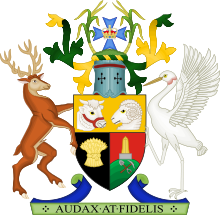Magistrates Court of Queensland
 From Wikipedia - Reading time: 8 min
From Wikipedia - Reading time: 8 min
| Magistrates Court of Queensland | |
|---|---|
 | |
 The Brisbane Magistrates Court building, a location of the Magistrates Court | |
| Jurisdiction | |
| Location | 130 locations across Queensland |
| Composition method | Vice-regal appointment upon nomination by the Premier following the advice of the Attorney-General and Cabinet |
| Authorised by | Queensland Parliament via the: Magistrates Courts Act 1921 (QLD) |
| Appeals to | District Court of Queensland |
| Judge term length | Mandatory retirement by age 70 |
| Website | www.courts.qld.gov.au |
| Chief Magistrate of Queensland | |
| Currently | Judge Janelle Brassington [1] |
| Since | 8 July 2022 |
| Deputy Chief Magistrate of Queensland | |
| Currently | Anthony Gett & Stephen Courtney [2] |
| Queensland Court Hierarchy |
|---|
 |
| Federal Law Courts |
| Queensland Law Courts |
|
| Tribunals |
The Magistrates Court of Queensland is the lowest court in the court hierarchy of Queensland, Australia.[3] All criminal proceedings in Queensland begin in the Magistrates Court, with minor offences being dealt with summarily, and more serious ones being referred to a higher court on the strength of evidence.[3] Most criminal cases are first heard in the Magistrates Court, as are most civil cases. The Magistrates Court hears approximately 95% of all court cases in Queensland.[4]
Decisions made by the Magistrates Court may be heard on appeal to the District Court of Queensland. The Magistrates Court does not have an appellate jurisdiction.
The Chief Magistrate of Queensland, since 2022, is Judge Janelle Brassington.[1]
Jurisdiction
[edit]Civil
[edit]The Magistrates Court has the jurisdiction to decide on civil matters for which the amount in dispute is less than or equal to A$150,000.[5] Civil matters in which the amount in dispute is more than $150,000 are decided by either the District Court or the Supreme Court.[5]
Criminal
[edit]The Magistrates Court has the jurisdiction to decide on charges of summary offences, and indictable offence which may be heard summarily.[5]
The Magistrates Court also conducts committal hearings in which the presiding magistrate decides, based on the strength of the evidence, whether to refer the matter to a higher court.[5]
Procedure
[edit]Those present at court typically include the magistrate, police prosecutor, defendant, plaintiff and witnesses for either party. It is a condition that those who enter the court bow to the Queensland Coat of Arms, situated behind the Bench, upon entry. Plaintiffs, defendants, their counsel and witnesses must rise when they wish to address the bench or when addressed by the magistrate.
Members of the media and general public are allowed into the courtroom, except where a party to the proceedings is under 18 in which case the court becomes a child court and the media and public will only have restricted access to the court.
Notable former magistrates
[edit]See also
[edit]References
[edit]- ^ a b "New Chief Magistrate and Magistrate appointed". 4 July 2019. Retrieved 24 February 2020.//
- ^ "Magistrates in Queensland". 24 February 2020. Retrieved 24 February 2020.
- ^ a b "Magistrates Courts". Department of Justice and Attorney-General (Queensland). Government of Queensland. 3 August 2016. Retrieved 4 August 2016.
- ^ "About Magistrates Courts". Courts. Queensland Government. 5 November 2013. Retrieved 4 August 2016.
- ^ a b c d "Magistrates Court of Queensland" (PDF). Department of Justice and Attorney-General (Queensland). Government of Queensland. 2010. Archived from the original (PDF) on 11 February 2014. Retrieved 15 June 2012.
Attribution
[edit] This Wikipedia article incorporates text from About Magistrates Courts published by the State of Queensland under CC-BY 3.0 AU licence (accessed on 4 August 2016).
This Wikipedia article incorporates text from About Magistrates Courts published by the State of Queensland under CC-BY 3.0 AU licence (accessed on 4 August 2016).
 KSF
KSF